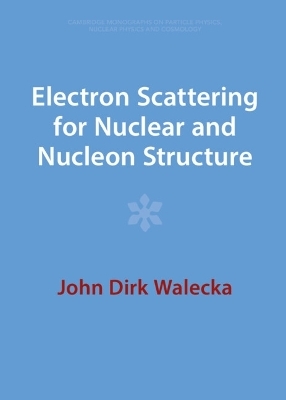
Electron Scattering for Nuclear and Nucleon Structure
Cambridge University Press (Verlag)
978-1-009-29057-9 (ISBN)
The scattering of high-energy electrons from nuclear and nucleon targets provides a microscope for examining the structure of these tiny objects. The best evidence we have on what nuclei and nucleons actually look like comes from electron scattering. This 2001 book examines the motivation for electron scattering and develops the theoretical analysis of the process. It discusses our theoretical understanding of the underlying structure of nuclei and nucleons at appropriate levels of resolution and sophistication, and summarizes experimental electron scattering capabilities. Only a working knowledge of quantum mechanics and special relativity is assumed, making this a suitable textbook for graduate and advanced undergraduate courses. It will also provide a valuable summary and reference for researchers already working in electron scattering and other areas of nuclear and particle physics. This text has been reissued as an Open Access publication on Cambridge Core.
John Dirk Walecka was Professor of Physics at Stanford University from 1966 to 1987 and then went on to become Scientific Director of the Continuous Electron Beam Accelerator Facility (CEBAF) from 1986 to 1992. He is now Governor's Distinguished CEBAF Professor of Physics, Emeritus at the College of William and Mary. He has published numerous papers on nuclear physics, and in 1996 the American Physical Society recognized his work with the award of the Bonner Prize.
Part I. Introduction: 1. Motivation; 2. Pictures of the nucleus; 3. Some optics; 4. Why electron scattering?; 5. Target response surfaces; 6. Why coincidence experiments?; 7. Units and conventions; Part II. General Analysis: 8. Electromagnetic interactions; 9. Multipole analysis; 10. Dirac equation; 11. Covariant analysis; 12. Excitation of discrete states in (e, e*); 13. Coincidence experiments (e, e* X); 14. Deep inelastic scattering from the nucleon; 15. Polarization in deep inelastic scattering; 16. Parity violation in inclusive electron scattering; Part III. Quantum Electrodynamics: 17. Basic elements; 18. Radiative corrections; Part IV. Selected Examples: 19. Basic nuclear structure; 20. Some applications; 21. A relativistic model of the nucleus; 22. Elastic scattering; 23. Quasielastic scattering; 24. The quark model; 25. Quantum chromodynamics; 26. The standard model; 27. Parity violation; 28. Excitation of nucleon resonances; Part V. Future Directions: 29. TJNAF(CEBAF); 30. Other facilities; 31. Future directions; Appendixes.
| Erscheinungsdatum | 30.01.2023 |
|---|---|
| Reihe/Serie | Cambridge Monographs on Particle Physics, Nuclear Physics and Cosmology |
| Zusatzinfo | Worked examples or Exercises |
| Verlagsort | Cambridge |
| Sprache | englisch |
| Maße | 185 x 262 mm |
| Gewicht | 910 g |
| Themenwelt | Schulbuch / Wörterbuch |
| Naturwissenschaften ► Physik / Astronomie ► Atom- / Kern- / Molekularphysik | |
| ISBN-10 | 1-009-29057-6 / 1009290576 |
| ISBN-13 | 978-1-009-29057-9 / 9781009290579 |
| Zustand | Neuware |
| Haben Sie eine Frage zum Produkt? |
aus dem Bereich


